The Man from U.N.C.L.E. #3 – “The Copenhagen Affair”
By John Oram
First Published in 1965
Published by Ace Books
144 Pages
The Man from U.N.C.L.E. had one of the most successful tie-in lines of all time, with 23 novels published between 1965 and 1968 by Ace Books. A 24th novel was written by never published (read about it here). Sixteen of these novels were also published in the United Kingdom with different covers and a different numbering system. I have seven of these novels, the last being #11. Many of the latter novels are quite hard to find these days. Amazon.com has copies of #23 with prices as high as $207.06 (it might actually be cheaper to buy the U.K. version).
What struck me the most about “The Copenhagen Affair” was the level of violence. Certainly, The Man from U.N.C.L.E. was a violent show, with plenty of gun play and fist fights, but it wasn’t necessarily bloody, especially during the rather campy third season. This novel, though, is quite explicit. Illya Kuryakin shoots one particularly evil women between the eyes. Earlier, several bad guys are killed during a gun battle:
It certainly was not a scene of domestic bliss. Rabbit Face was sprawling near the door with half his head shot away. Eiler, center stage, grinned vacantly at the shattered ceiling with a blue hole between his eyes. A huddle of duffel coat in a pool of blood represented all that was left of the saturnine Bjorn.
The novel isn’t all blood and guts, though. The THRUSH threat of the week is a flying saucer of sorts, one that is very, very dangerous but one that also doesn’t have all the kinks ironed out. The prototypes have to be blown up in mid-air rather than crash to Earth. Napoleon Solo is sent to Denmark to track down a man named Garbridge who is in charge of the saucer program.
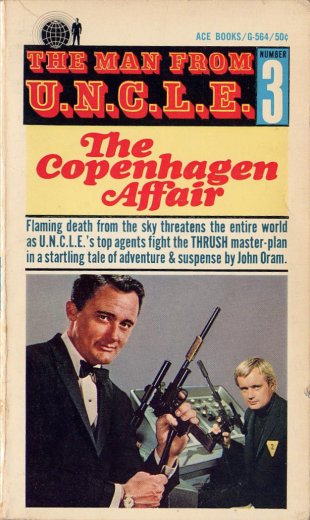
The Copenhagen Affair Front – Copyright 1965 Ace Books
Solo gets himself captured by Garbridge and his thugs but manages to escape and soon meets up with Illya. The two join forces with another U.N.C.L.E. agent, a red-head named Karen, and some former Danish resistance fighters from World War II who can be trusted. They find Garbridge’s underground plant and plan to destroy it. They’re able to knock out most of the T.H.R.U.S.H. agents/scientists inside but Garbridge gets away with Karen.
Karen is brought to a maternity home that doubles as a T.H.R.U.S.H. facility where she meets a vile women named Ingrid who worked as an interrogator during World War II. She has a room full of nasty whips and chains and hooks and electrical devices. Karen faints. Thankfully, before Ingrid can spend too much time with Karen, Solo and Napoleon arrive to rescue her. But Garbridge gets away again.
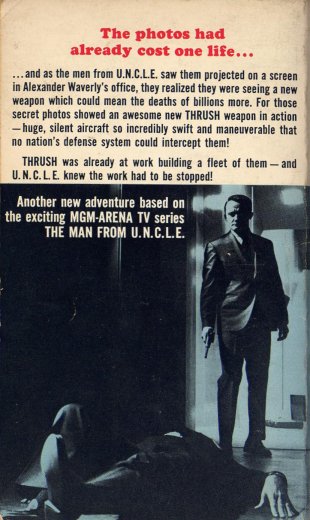
The Copenhagen Affair Back – Copyright 1965 Ace Books
The two track Garbridge back to his facility where he jumps in his saucer and tries to fly away. Instead, he crashes and dies in a giant explosion. Karen recovers sufficiently to join Napoleon and Illya for dinner.

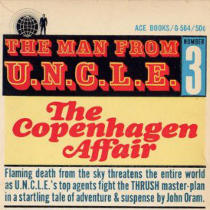

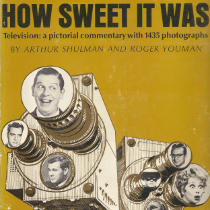
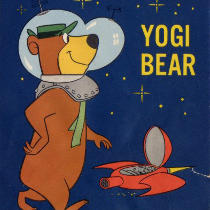



There were things you could “get away with” in books that you couldn’t on television, including more overt violence and its consequences. No doubt the original “MAN FROM U.N.C.L.E.” novels were popular BECAUSE they could “show more” than its TV counterpart (but don’t “look” for Solo, Illya and Karen having a cozy “threesome” after dinner; there were SOME things that were off-limits in these authorized novels).
The U.N.C.L.E. novels at their best amplified what was shown on the series, gave us more (and frequently more believable) detail than we got in the aired episodes. The first three, “Thousand Coffins Affair” (Michael Avallone), “Doomsday Affair” (pulpster Harry Whittington), and “Copenhagen” are rather grim, tough affairs; in them Solo and Illya almost have more in common with the tough private eyes of Hammett and Chandler, and with Fleming’s Bond, than with their TV incarnations. David McDaniel’s novels have more of the show’s sense of play and imagination, without ever being silly.
I’ve also read somewhere that Oram based this Denmark setting and the former Resistance fighter characters on the WWII experiences of some members of his family. He also bet a friend that he could write a readable and publishable thriller set in Wales, and did it with the later MfU novel “Stone Cold Dead in the Marketplace Affair.”